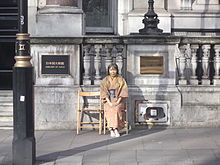
Becoming a Missing Comfort Women
Yoshiko Shimada’s Performances of History in Contemporary Japan
By Jessica Nakamura
Jessica Nakamura’s lecture was about exploring the image of the comfort women during World War two. Comfort women were essentially forced prostitutes from Asian countries concurred by the Japanese army. It is estimated that one hundred to two hundred thousand women from the countries of Korea, China, Vietnam, and even Japan were forced to sexually serve an average of 20 to 60 men a day. The army saw these women as supplies for the men, but conditions were often horrible. Many women were as young as 15 years old when taking and were often left behind or killed when the army retreated. Today, Japan sees this history as a stain on their image, even going to great lengths to destroy evidence and documentation. According to Ms. Nakamura, there is a taboo that follows women who identify or say they were used as comfort women. However, in 1991 former comfort women took their fight to the court systems in Japan. As of 2015, there was some recognition on the Japanese government but they can with stipulations many people were hesitated to agree too.
Ms. Nakamura focuses are Yoshiko Shimada’s “Becoming a Statue of a Japanese Comfort Woman” 2012. Shimada started her work during the early 1990s, when the comfort women went to court, because many Japanese people were unaware of this dark history. This piece, performed in London outside the Japanese Embassy as a reaction the government denial to recognize them. Nakamure argues that Shimada’s piece demands the audience (people walking by) engage with her physical form, creating a relationship. Because youth of Japan isn’t aware of the role of comfort women in WW2, Shimada intents to stop the brainwashing and force them to recognize and interact with the symbolism of Japanese violence and aggression towards women.

Nakamura also discussed the Bronze statue in Seoul Korea (also outside the Japanese Embassy). The piece is an image of a woman sitting with her feet and hand placed flat. Nakamure argues that the statue explores the idea of female sexuality, meaning the audience calls the statue “grandmother” essentially erasing her sexuality, which in turn, diminishes the horrible conditions these women went through.
Overall, the lecture was a reminder to the younger generations about the horrors of war and the violence it inflicts on people. Sadly, many comfort women have not come forward and those who have, many not live long enough to see any compensation from the Japanese government. However, Jessica Nakamura does end on a positive note: Yoshiko Shimada’s piece and other comfort women statues around the world will continue to stand and serve as a reminder of injustices and violence towards women.
No comments:
Post a Comment